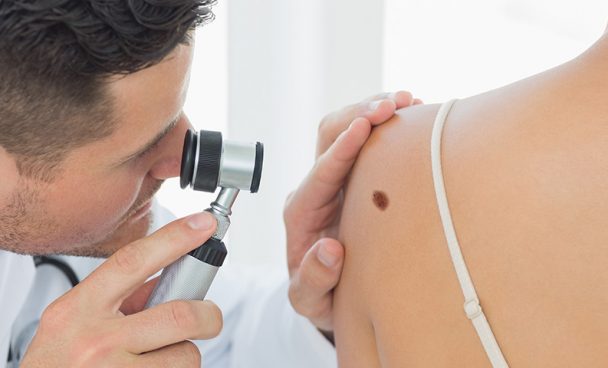Skin cancer is a disease caused by the abnormal and uncontrolled growth of cells that make up the skin. It can be of two types: melanoma and non-melanoma (basal cell and squamous cell carcinomas).
Melanoma is the most serious type of skin cancer, due to the possibility of metastasis (spread to other organs).
It is also the rarest in the universe of neoplasms that affect the skin. For 2020, INCA (National Cancer Institute) estimated 8,450 new cases of melanoma in Brazil, compared to 185,380 total cases of skin cancer (about 4.5%, therefore). It is important to note, however, that skin cancer is known to be underreported, which means that the actual numbers of cases tend to be much higher.
In the world, of the 1.3 million total annual cases of skin cancer, about 300 thousand are melanomas (approximately 23%).
Melanoma originates in melanocytes – the cells that produce melanin (the substance that determines skin color). Melanoma can appear anywhere on the body, on the skin or mucous membranes, and manifests itself in the form of spots, moles or moles. It is more common in white adults, but can also affect black and other ethnicities.
Its most frequent causes are prolonged and repeated exposure to the sun’s ultraviolet rays (especially in childhood and adolescence) and artificial tanning beds.
Symptoms of Melanoma
The main initial manifestation of melanoma is the appearance of a dark spot with irregular borders, which may be accompanied by itching and scaling. It can arise from normal skin or from a previous pigmented lesion – in the latter case, there is an increase in the size, change in color and shape of the lesion.
The ABCDE rule, adopted internationally, helps the patient and healthcare professionals to better identify a mole that could be a melanoma-type skin tumor. The letters correspond to:
- Asymmetry – one half of the mole is different from the other;
- Irregular edges – ill-defined contour;
- Variable color – the same lesion may have the presence of several colors, such as black, brown, white, red and blue;
- Diameter – greater than 6 millimeters;
- Evolution – observed changes in characteristics such as size, shape or color.
The places on the body where melanoma most commonly appears are those exposed to the incidence of sunlight: legs, trunks, neck and face, and may also appear in covered areas. In people with black skin, it is common to appear in light areas, such as the palms of the hands and soles of the feet.
When noticing these skin changes, it is important to go through an appointment with a doctor. Your trusted doctor, family doctor, general practitioner, gynecologist and dermatologist can assess the need for investigation.
Diagnosis of Melanoma
The first step in diagnosing melanoma skin cancer is a clinical examination by a physician. The dermatologist plays an important role in obtaining a qualified evaluation.
Once the possibility of a mole being a melanoma is detected, dermoscopy is performed, an exam exclusively performed by the dermatologist in which a device allows the visualization of some layers of the skin that are not seen with the naked eye. Usually, it needs to be complemented with histopathological examination, which is the evaluation of the abnormality, partially or completely removed by biopsy. It is there that the diagnosis is confirmed and the indication of the best type of treatment is indicated.
In some cases, dermoscopy can spare patients from biopsy, an invasive test that leaves a surgical scar on the skin.
Treatment
If detected at an early stage, melanoma is treated with surgery performed by a doctor experienced in these procedures (dermatologist or cancer surgeon). In this scenario, healing rates can be very high (close to 100%).
The assessment of risk factors obtained by biopsy and recognition of the nodes in the region (sentinel lymph node) for the dissemination or recurrence of the disease is carried out at this time, since treatments administered in the early phase (adjuvants) reduce the risk of recurrence.
In more advanced stages and with metastasis, radiotherapy, chemotherapy, immunotherapy and targeted therapy can be used. The strategy should be defined with the objective of delaying the evolution of the disease and offering a greater chance of survival to the patient.
Prevention
Since the biggest risk factor for the emergence of melanoma skin cancer is exposure to the sun’s ultraviolet rays, the best form of prevention is to avoid unprotected skin exposure from 10 am to 4 pm, when its incidence is most intense.
Even before and after these times, it is recommended to protect the skin with shade (natural or with an umbrella, umbrella and tent), clothes, caps and hats, sunglasses with UV protection on the lenses. On the skin, a filter or sunscreen with an SPF of at least 30 should be applied. Lips require specific products for their most delicate skin.
It is also important to avoid artificial tanning beds – it is worth remembering that they have been banned in Brazil by Anvisa (National Health Surveillance Agency) since 2009.
